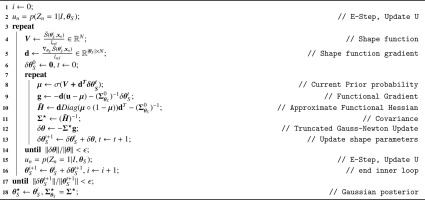Abstract
The paper presents a method for cochlea image segmentation. The authors compare their method with prior work on cochlea segmentation, considering studies evaluated on clinical CT images and discarding the literature on the segmentation of µCT images or of the scala tympani and vestibuli located inside the cochlea. The relevant publications on cochlea segmentation are split into unsupervised and supervised methods. The unsupervised approaches are mostly based on cochlear shape fitting based on template image registration, parametric shape model. The supervised methods are based on statistical deformation models and deep learning. The paper’s unsupervised approach performs as well as the supervised methods with Dice scores in the range [0.85, 0.91] and outperforms previous unsupervised methods. The paper also discusses an unsupervised quality control algorithm that computes for each image segmentation, an average distance between the segmentation provided by their algorithm and a segmentation produced by a simple generic probabilistic method. The Dice score decreases as the Average Surface Error (ASE) increases, indicating that the ASE may be a proper surrogate for the segmentation performance. The paper concludes that a more thorough study with far more manual segmentations is necessary to be less speculative about the actual performance on clinical CT data.
Key Words: Cochlea Image Segmentation, Bayesian Logistic Shape Model, Unsupervised Quality Control, Average Surface Error, Dice Score
Main points
- Compares the proposed method with prior work on cochlea segmentation.
- The unsupervised approach performs as well as the supervised methods with Dice scores in the range [0.85, 0.91] and outperforms previous unsupervised methods.
- Discusses an unsupervised quality control algorithm that computes for each image segmentation, an average distance between the segmentation provided by their algorithm and a segmentation produced by a simple generic probabilistic method.
- The Dice score decreases as the Average Surface Error (ASE) increases, indicating that the ASE may be a proper surrogate for the segmentation performance.
- Concludes that a more thorough study with far more manual segmentations is necessary to be less speculative about the actual performance on clinical CT data.
Citation
@article{zihao2021bayesian,
title={Bayesian Logistic Shape Model Inference: application to cochlea image segmentation},
author={Wang Zihao and Demarcy Thomas and Vandersteen Clair and Gnansia Dan and Raffaelli Charles and Guevara Nicolas and Delingette Hervé},
journal={arXiv},
year={2021},
url={https://arxiv.org/pdf/2105.02045.pdf}
}
